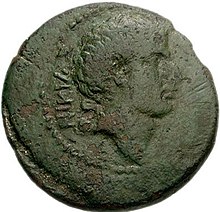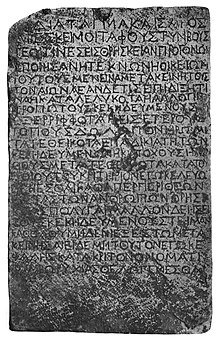Nicias of Kos
Nikias of Kos | |
|---|---|
 | |
| Occupation | Ruler of Kos |
| Years active | c. 50 BCE to c. 20 BCE |

Nicias (Ancient Greek: Νικίας; died circa 20 BCE) was a ruler of the island of Kos under Roman rule, during the Second Triumvirate and the early reign of Augustus. He is known from coinage, inscriptions, and anecdotes in ancient literary sources. Ancient sources call him a tyrant. The desecration of his tomb may have prompted the Nazareth Inscription.
Reign[]
The date of Nicias' coinage and of anecdotes about him in literary sources indicate that he ruled during the Second Triumvirate and into the reign of Augustus.[1] He appears to have led a regime at Cos that supported Augustus' opponent Mark Antony and to have remained in power after Augustus defeated Antony at the Battle of Actium in 31 BC.[2][3]
Aelian reports in his Varia Historia that Nicias had a sheep that gave birth to a lion, which was a sign that he would be tyrant.[4] Kostas Buraselis identifies this story as a literary trope, designed to reinforce a ruler's legitimacy and perhaps also indicating that Nicias came from low birth.[5] Anna Heller accepts the former possibility, but is sceptical about the latter.[3]
Bronze coins created during Nicias' rule begin around 50 BCE.[6] On the obverse they have a portrait of a "young man with rather curly hair, broad forehead, hooked nose, some sparse chin hair, and a serious expression conveyed by his eyes and the downward line of his lips" and the legend "Nicias" (Ancient Greek: ΝΙΚΙΑΣ).[7] On the reverse, they have a portrait of Asclepius (the patron god of Kos) and two legends, one naming the annual mint magistrate and another reading "of the Koans" (Ancient Greek: ΚΩΙΩΝ)[7][8] Nicias wears a headband, which has been identified by some scholars as a diadem (the symbol of kingship in the Hellenistic period), a wreath, or an infula - a knotted band associated with sacred beings and designed to assimilate him to the god Asclepius.[9]
Altars[]
More than twenty little stone altars associated with Nicias have been found on Kos, all of which bear an identical text:
θεοῖς πατρῴοις ὑπὲρ τᾶς Νικία τοῦ δάμου υἱοῦ, φιλοπάτριδος, ἥρωος, εὐεργέτα, δὲ τᾶς πόλιος σωτηρίας
(Dedicated) to the ancestral gods, for the well-being of Nicias, son of the People, Lover of the Fatherland, Hero, and Benefactor of the city.
The number and modest size of these altars indicates that they were originally set up in private houses. The uniformity of their inscriptions suggests that they were erected in response to a decree - perhaps from Nicias himself.[10] The inscription on these altars closely identifies Nicias with Kos and its people, presenting his devotion to the state as equivalent to the filial piety of a son to his father.[11] This is the first attestation of the title "son of the People (damos, Doric Greek for demos)," which would become a common honorific for civic benefactors in the Roman Imperial period.[3] Usually, Greek individuals are named with a patronymic (the name of their father), but this is absent from all the altars. Kostas Buraselis suggests that this was intended to present him as a 'man of the people', to obscure a humble birth, and to present himself as semi-divine.[12][13] According to Anna Heller, the association with a humble birth is unpersuasive, and the lack of the patronymic should be understood as an effort to emphasise Nicias' filial devotion to Kos and a result of the novelty of the "son of the People" title.[14] The formula "for the well-being of" derives from dedications erected in honour of Hellenistic kings.[15]
Posthumous fate and reputation[]

After his death, Nicias was remembered as a tyrant. The geographer Strabo calls him a tyrant who was opposed by the "renowned harper" Theomnestus.[16] A bust of a child, known only from a short report and photography published by G. Iakopich in 1928, bears a graffito reading "Nicias the tyrant" that may form part of a denigration of Nicias following his death.[17]
According to a poem on Nicias by the epigrammatist Crinagoras of Mytilene preserved in the Palatine Anthology, Nicias' tomb was desecrated after his death:[18]
Tell me not that death is the end of life.
The dead, like the living, have their own causes of suffering.
Look at the fate of Nicias of Cos.
He had gone to rest in Hades, and now his dead body has come again into the light of day.
For his fellow-citizens, forcing the bolts of his tomb, dragged out the poor hard-dying wretch to punishment.
In 2020, researchers showed that the Nazareth Inscription, an edict proclaimed by a Caesar, which banns the desecration of tombs and is sometimes connected with the tomb of Jesus, is made from Koan marble. They proposed that it might have bee issued by Augustus following the desecration of Nicias' tomb by the people of Kos.[19][20]
A decree from Kos, probably dating to the late first century AD, revises the list of priests of Apollo as part of a process of destroying and replaces "all the inadmissibly and illegally engraved inscriptions". The illegal priests seem to be those who served during Nicias' reign. Buraselis proposes that the long delay between Nicias' death and the reform of this list indicates that immediately after his death there was significant continuity, with positive and negative perspectives on him in conflict with one another.[21]
References[]
- ^ Buraselis 2000, p. 37.
- ^ Buraselis 2000, pp. 27–30.
- ^ a b c Heller 2020, pp. 42–49.
- ^ Claudius Aelianus. "Varia Historia" (in Greek). Translated by Thomas Stanley. p. Book 1, Chapter 29.
- ^ Buraselis 2000, p. 38.
- ^ Buraselis 2000, p. 30.
- ^ a b Buraselis 2000, p. 31.
- ^ "Coin of Kos with bust of Nikias". Museum of Fine Arts, Boston. Archived from the original on 29 February 2020. Retrieved 29 February 2020.
- ^ Buraselis 2000, pp. 31–33.
- ^ Buraselis 2000, pp. 33–35.
- ^ Buraselis 2000, pp. 45–55.
- ^ Buraselis 2000, pp. 37–39.
- ^ The Damos was worshipped as a god by the Koans in Nicias' time.
- ^ Heller 2020, pp. 48–49.
- ^ Buraselis 2000, pp. 60–64.
- ^ Strabo. "Geographica". p. Book XIV, Chapter 2. Retrieved 29 February 2020.
- ^ Buraselis 2000, pp. 40–41.
- ^ Crinagoras of Mytilene. "Epigrams". Translated by William Roger Paton. Archived from the original on 15 September 2019. Retrieved 29 February 2020.
- ^ Gibbons, Ann (February 28, 2020). "Tablet thought to have guarded tombs after Jesus's death may not be what it seems". Science Magazine. Archived from the original on February 29, 2020. Retrieved February 29, 2020.
- ^ Harper, Kyle; McCormick, Michael; Hamilton, Matthew; Peiffert, Chantal; Michels, Raymond; Engel, Michael (April 2020). "Establishing the provenance of the Nazareth Inscription: Using stable isotopes to resolve a historic controversy and trace ancient marble production". Journal of Archaeological Science: Reports. 30: 102228. doi:10.1016/j.jasrep.2020.102228.
- ^ Buraselis 2000, pp. 40–44.
Bibliography[]
- Buraselis, Kostas (2000). Kos Between Hellenism and Rome. American Philosophical Society. pp. 30–64. ISBN 9780871699046. Retrieved 29 February 2020.
- Harper, Kyle; McCormick, Michael; Hamilton, Matthew; Peiffert, Chantal; Michels, Raymond; Engel, Michael (April 2020). "Establishing the provenance of the Nazareth Inscription: Using stable isotopes to resolve a historic controversy and trace ancient marble production". Journal of Archaeological Science: Reports. 30: 102228. doi:10.1016/j.jasrep.2020.102228.
- Heller, Anna (2020). L'âge d'or des bienfaiteurs : titres honorifiques et sociétés civiques dans l'Asie Mineure d'époque romaine : Ier s. av. J.-C.-s. - IIIe apr. J.-C. Genève. pp. 42–49. ISBN 978-2-600-05746-2.
- Ancient Greek rulers